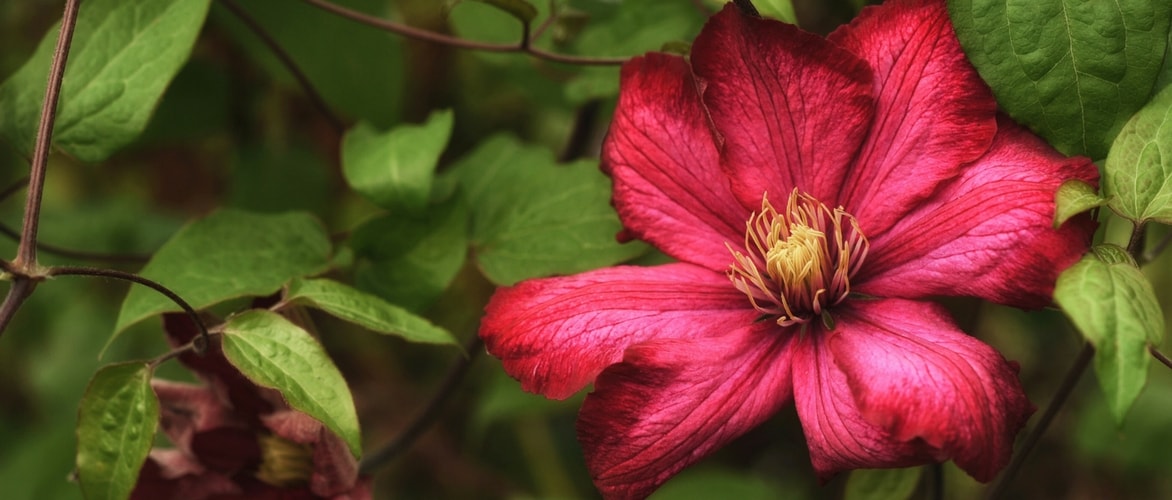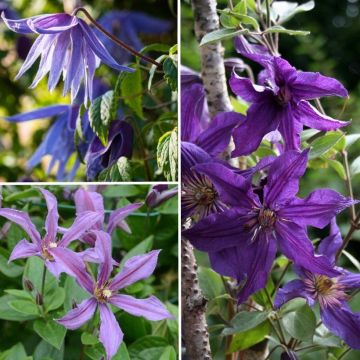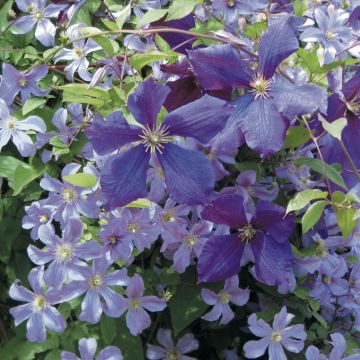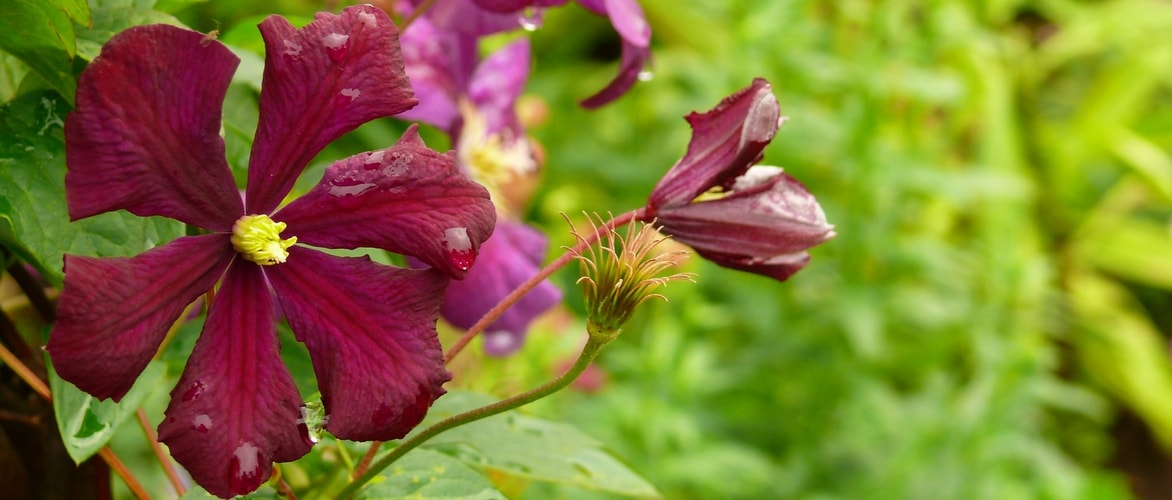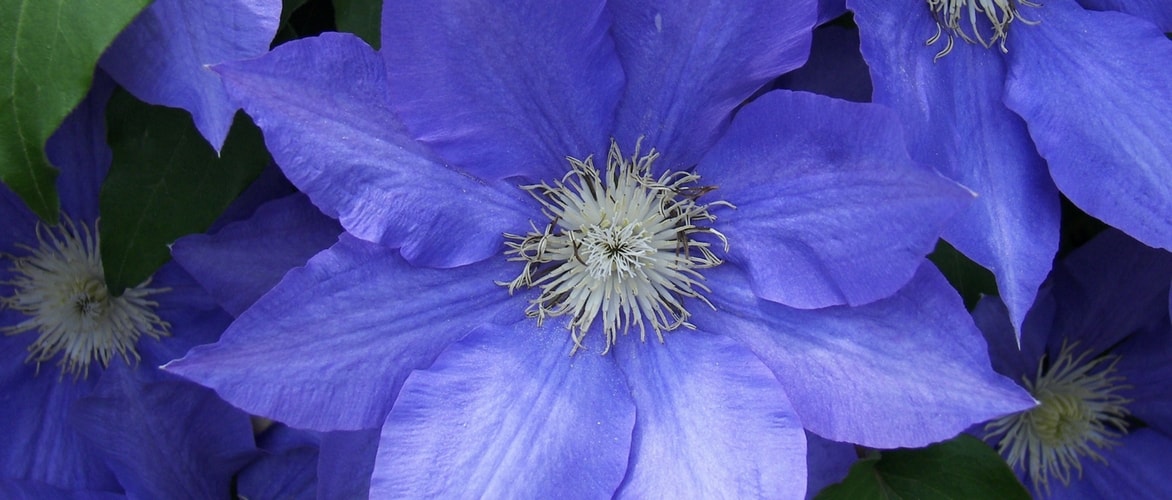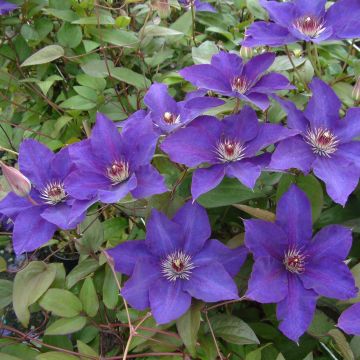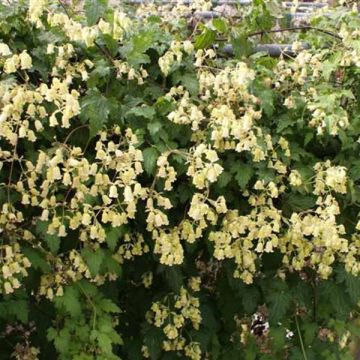

Abundance duo - Clematis Perle d'Azur and Rose Excelsa
Abundance duo - Clematis Perle d'Azur and Rose Excelsa
Clematis, Rosa Perle d'Azur, Excelsa
Special offer!
Receive a €20 voucher for any order over €90 (excluding delivery costs, credit notes, and plastic-free options)!
1- Add your favorite plants to your cart.
2- Once you have reached €90, confirm your order (you can even choose the delivery date!).
3- As soon as your order is shipped, you will receive an email containing your voucher code, valid for 3 months (90 days).
Your voucher is unique and can only be used once, for any order with a minimum value of €20, excluding delivery costs.
Can be combined with other current offers, non-divisible and non-refundable.
Home or relay delivery (depending on size and destination)
Schedule delivery date,
and select date in basket
This plant carries a 6 months recovery warranty
More information
We guarantee the quality of our plants for a full growing cycle, and will replace at our expense any plant that fails to recover under normal climatic and planting conditions.
Would this plant suit my garden?
Set up your Plantfit profile →
Collection items (2 plants)
Description
Here is a powerful and highly flowering duo in summer, remarkably complementary, where the azure blue stars of the clematis temper the bright cherry red pompoms of the rose. You can place these two climbing plants on a fence, an old tree, a cabin, or any small structure that they will uniquely embellish.
This Abundance duo consists of a climbing rose 'Excelsa' and a clematis 'Perle d'Azur'.
- The Climbing rose 'Excelsa', often called Red Dorothy Perkins, produces small, double roses with a diameter of 3 cm (1in) in June-July for 4 weeks. These roses are a bright crimson red color and are gathered in hanging bouquets along the branches. It develops thorny stems up to 4 m (13ft) long that will need to be trained on a support. It can also be grown as a large bush. Despite its susceptibility to powdery mildew, this old variety remains one of the most well-known and appreciated by gardeners worldwide.
- The Clematis 'Perle d'Azur', an old variety derived from the Italian Clematis, is a small liana that grows up to 3.5 m (11ft) and is very easy to grow in any region. It is particularly floriferous from June to early October and resistant to diseases. From July to October, it produces pale mauve buds that open into 10 cm (4in) flowers with a bright azure blue colour, sometimes touched with mauve, and highlighted by cream stamens in the center. The flowering is followed by decorative silvery grey feathery fruits that persist until winter.
Clematis naturally pairs well with climbing roses to extend the flowering season on walls and pergolas until the end of summer. Place this duo at the base of a large bush, in a flowering hedge, on a wire fence, or near a small structure that you want to embellish. To accompany them, consider beautiful perennials such as geraniums, carnations, garden irises, peonies, and nemorosa salvias, which will provide the shade that the clematis appreciates at its base. Take advantage of the easy cultivation of viticella clematis and climbing roses to give your garden a romantic and bohemian touch.
Plant habit
Flowering
Foliage
Botanical data
Clematis, Rosa
Perle d'Azur, Excelsa
Cultivar or hybrid
Other Clematis collections
View all →Planting and care
For the rose:
Plant the climbing rose 'Excelsa' in ordinary, well-loosened, and drained soil. Roses prefer clayey soils, rather heavy than light. In too sandy, compact, or dry soil in summer, it is preferable to bury decomposed manure, or compost at the bottom of the planting hole. However, this rose dreads waterlogged soils in winter. Install it about 20 cm (8in) from its support in a sunny position, at most in partial shade in the morning sun. Roses are demanding plants, specific fertilizer application will be beneficial at the start of vegetation, and regularly throughout the flowering period.
For the Clematis:
The 'Perle d'Azur' Clematis will appreciate a sunny or lightly shaded position near a tree. Plant it in rather fertile soil, enriched with leaf compost, especially well-drained, shading the roots and the base of the stem (with a flat tile, for example). Generally, the Clematis withers in overly moist soil, but varieties derived from C. viticella seem less sensitive and are generally very easy to grow in ordinary, well-loosened soil. Install it by covering the slanted root ball with 3 cm (1in) of soil, in soil worked to a depth of 20 cm (8in), lightened with good compost and coarse sand. After planting, cut back the Clematis stems to about 30 cm (12in) from the base above a nice pair of buds. Water regularly during the first few weeks. However, be careful not to let water stagnate as it can cause fungus development at the neck. Mulch all Clematis in February with garden compost or well-decomposed manure, avoiding direct contact with the stems. Train the stems without squeezing them until the plant can grip itself.
After a few years, cover the base of your climbing Clematis with a small mound of soil, to reduce the risk of withering while promoting the growth of vigorous shoots from the stump.
To save space, you can perfectly plant your Clematis and climbing rose in the same hole: dig a pit at least 70 cm (28in) wide and 50 cm (20in) deep. Fill it with a mixture of garden soil and compost. Remember to choose a location where the base of the plants will be shaded, primarily to meet the needs of the Clematis.
Planting period
Intended location
Care
Planting & care advice
This item has not been reviewed yet - be the first to leave a review about it.
Similar products
Haven't found what you were looking for?
Hardiness is the lowest winter temperature a plant can endure without suffering serious damage or even dying. However, hardiness is affected by location (a sheltered area, such as a patio), protection (winter cover) and soil type (hardiness is improved by well-drained soil).

Photo Sharing Terms & Conditions
In order to encourage gardeners to interact and share their experiences, Promesse de fleurs offers various media enabling content to be uploaded onto its Site - in particular via the ‘Photo sharing’ module.
The User agrees to refrain from:
- Posting any content that is illegal, prejudicial, insulting, racist, inciteful to hatred, revisionist, contrary to public decency, that infringes on privacy or on the privacy rights of third parties, in particular the publicity rights of persons and goods, intellectual property rights, or the right to privacy.
- Submitting content on behalf of a third party;
- Impersonate the identity of a third party and/or publish any personal information about a third party;
In general, the User undertakes to refrain from any unethical behaviour.
All Content (in particular text, comments, files, images, photos, videos, creative works, etc.), which may be subject to property or intellectual property rights, image or other private rights, shall remain the property of the User, subject to the limited rights granted by the terms of the licence granted by Promesse de fleurs as stated below. Users are at liberty to publish or not to publish such Content on the Site, notably via the ‘Photo Sharing’ facility, and accept that this Content shall be made public and freely accessible, notably on the Internet.
Users further acknowledge, undertake to have ,and guarantee that they hold all necessary rights and permissions to publish such material on the Site, in particular with regard to the legislation in force pertaining to any privacy, property, intellectual property, image, or contractual rights, or rights of any other nature. By publishing such Content on the Site, Users acknowledge accepting full liability as publishers of the Content within the meaning of the law, and grant Promesse de fleurs, free of charge, an inclusive, worldwide licence for the said Content for the entire duration of its publication, including all reproduction, representation, up/downloading, displaying, performing, transmission, and storage rights.
Users also grant permission for their name to be linked to the Content and accept that this link may not always be made available.
By engaging in posting material, Users consent to their Content becoming automatically accessible on the Internet, in particular on other sites and/or blogs and/or web pages of the Promesse de fleurs site, including in particular social pages and the Promesse de fleurs catalogue.
Users may secure the removal of entrusted content free of charge by issuing a simple request via our contact form.
The flowering period indicated on our website applies to countries and regions located in USDA zone 8 (France, the United Kingdom, Ireland, the Netherlands, etc.)
It will vary according to where you live:
- In zones 9 to 10 (Italy, Spain, Greece, etc.), flowering will occur about 2 to 4 weeks earlier.
- In zones 6 to 7 (Germany, Poland, Slovenia, and lower mountainous regions), flowering will be delayed by 2 to 3 weeks.
- In zone 5 (Central Europe, Scandinavia), blooming will be delayed by 3 to 5 weeks.
In temperate climates, pruning of spring-flowering shrubs (forsythia, spireas, etc.) should be done just after flowering.
Pruning of summer-flowering shrubs (Indian Lilac, Perovskia, etc.) can be done in winter or spring.
In cold regions as well as with frost-sensitive plants, avoid pruning too early when severe frosts may still occur.
The planting period indicated on our website applies to countries and regions located in USDA zone 8 (France, United Kingdom, Ireland, Netherlands).
It will vary according to where you live:
- In Mediterranean zones (Marseille, Madrid, Milan, etc.), autumn and winter are the best planting periods.
- In continental zones (Strasbourg, Munich, Vienna, etc.), delay planting by 2 to 3 weeks in spring and bring it forward by 2 to 4 weeks in autumn.
- In mountainous regions (the Alps, Pyrenees, Carpathians, etc.), it is best to plant in late spring (May-June) or late summer (August-September).
The harvesting period indicated on our website applies to countries and regions in USDA zone 8 (France, England, Ireland, the Netherlands).
In colder areas (Scandinavia, Poland, Austria...) fruit and vegetable harvests are likely to be delayed by 3-4 weeks.
In warmer areas (Italy, Spain, Greece, etc.), harvesting will probably take place earlier, depending on weather conditions.
The sowing periods indicated on our website apply to countries and regions within USDA Zone 8 (France, UK, Ireland, Netherlands).
In colder areas (Scandinavia, Poland, Austria...), delay any outdoor sowing by 3-4 weeks, or sow under glass.
In warmer climes (Italy, Spain, Greece, etc.), bring outdoor sowing forward by a few weeks.
































